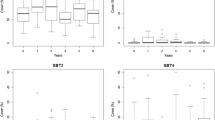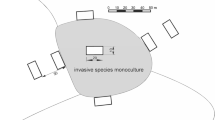Abstract
Human disturbance may change dominance hierarchies of plant communities, and may cause substantial changes in biotic environmental conditions if the new dominant species have properties that differ from the previous dominant species. We examined the effects of bamboos (Bambusa tulda and Cephalostachyum pergracile) and their litter on the overall woody seedling abundance, species richness and diversity in a mixed deciduous forest in northeastern Thailand. These bamboo species are gaining dominance after human disturbance. Our results show that seedling abundance and species richness were reduced by bamboo canopies. Seedling abundance and species diversity under bamboo canopies were affected by bamboo litter, whereas seedling abundance and species diversity outside bamboo canopies did not respond to the mixed-tree litter manipulation. Removal of bamboo litter increased seedling abundance and species diversity. However, bamboo litter addition did not affect seedling abundance or species diversity compared to either control or litter removal. This may indicate that the effect of natural amount of bamboo litter is as high as for litter addition in preventing seedling establishment by woody species and hence in minimizing resource competition. We conclude that undergrowth bamboos and their litter affect tree seedling regeneration differently from mixed-tree litter, causing changes in plant community composition and species diversity. Increased human disturbance, causing a shift in dominance structure of these forests, may result in a concomitant reduction in their overall woody species abundance, richness and diversity. Thus, management of bamboos by controlling their distribution in areas of high bamboo density can be an important forest restoration method.



Similar content being viewed by others
References
Abe M, Izaki J, Miguchi H, Masaki T, Makita A, Nakashizuka T (2002) The effects of Sasa and canopy gap formation on tree regeneration in an old beech forest. J Veg Sci 13:565–574
Becerra PI, Celis-Diez JL, Bustamante RO (2004) Effects of leaf litter and precipitation on germination and seedling survival of the tree Beilschmiedia miersii. Appl Veg Sci 7:253–257
Chou CH, Yang CM (1982) Allelopathic research of subtropical vegetation in Taiwan II comparative exclusion of understory by Phyllostachys edulis and Cryptomeria japonica. J Chem Ecol 8:1489–1507
Cintra R (1997) Leaf litter effects on seed and seedling predation of the palm Astrocaryum murumuru and the legume tree Dipterix micrantha in Amazonian. J Trop Ecol 13:709–725
Dhillion SS, Ampronpan L, Austreng I (2003) Land use and plant diversity in Ban Bung and Na Haeo Foreset Reserve. In: Ampornpan L, Dhillion SS (eds) The environment of Na Haeo, Thailand: biodiversity, non-timber products, land use and conversation. Craftsman Press, Bangkok, pp 47–81
Facelli JM, Pickett STA (1991a) Plant litter: its dynamics and effects on plant community structure. Bot Rev 57:1–32
Facelli JM, Pickett STA (1991b) Plant litter: light interception and effects on an old-field plant community. Ecology 72:1024–1031
Facelli JM, Pickett STA (1991c) Indirect effects of litter on woody seedlings subject to herb competition. Oikos 62:129–138
Facelli JM, Williams R, Fricker S, Ladd B (1999) Establishment and growth of seedlings of Eucalyptus obliqua: interactive effects of litter, water, and pathogens. Aust J Ecol 24:484–494
Forest Restoration Research Unit (2006) How to plant a forest: the principles and practice of restoring tropical forests. Biology Department, Science Faculty, Chiang Mai University, Chiang Mai
García-Guzmán G, Benítez-Malvido J (2003) Effect of litter on the incidence of leaf-fungal pathogens and herbivory in seedlings of the tropical tree Nectandra ambigens. J Trop Ecol 19:171–177
Gardner S, Sidisunthorn P, Anusarnsunthorn V (2000) Field guide to the forest trees of northern Thailand. Kobfai Publishing Project, Bangkok
Gratzer G, Rai PB, Glatzel G (1999) The influence of the bamboo Yushania microphylla on regeneration of Abies densa in Central Bhutan. Can J For Res 29:1518–1527
Green PT (1999) Seed germination in Chrysophyllum sp. nov., a large-seeded rainforest species effects of seed size, litter depth and seed position. Aust J Ecol 24:608–613
Griscom BW, Ashton PMS (2003) Bamboo control of forest succession: Guadua sarcocarpa in southeastern Peru. For Ecol Manage 175:445–454
Griscom BW, Ashton PMS (2006) A self-perpetuating bamboo disturbance cycle in a neotropical forest. J Trop Ecol 22:587–597
Guilherme FAG, Oliveira-Filho AT, Appolinário V, Bearzoti E (2004) Effects of flooding regime and woody bamboos on tree community dynamics in a section of tropical semideciduous forest in South-Eastern Brazil. Plant Ecol 174:19–36
Holz CA, Veblen TT (2006) Tree regeneration responses to Chusquea montana bamboo dieback in a subalpine Nothofagus forest in the southern Andes. J Veg Sci 17:19–28
Htun N (1998) Bamboos of Myanmar. In: Roa AN, Roa R (eds) Proceedings of the workshop “Bamboo conservation, diversity, ecogeography, germplasm, resource utilization and taxonomy”. Kunming and Xishuangbanna, Yunnan, China, 10–17 May
Larpkern P, Moe SR, Totland Ø (2009) The effects of environmental variables and human disturbance on woody species richness and diversity in a bamboo-deciduous forest in northeastern Thailand. Ecol Res 24:147–156
Lisanework N, Michelsen A (1994) Litterfall and nutrient release by decomposition in three plantations compared with a natural forest in the Ethiopian highland. For Ecol Manage 65:164–1489
Liu W, Fox JED, Xu Z (2000) Leaf litter decomposition of canopy trees, bamboo and moss in a montane moist evergreen broad-leaved forest on Ailao Mountain, Yunnan, south-west China. Ecol Res 15:435–447
Magurran AE (1988) Ecological diversity and its measurement. Princeton University Press, Princeton
Marod D, Kutintara U, Tanaka H, Nakashizuka T (1999) Structural dynamics of a natural mixed deciduous forest in western Thailand. J Veg Sci 10:777–786
Molofsky J, Augspurger CK (1992) The effect of leaf litter on early seedling establishment in a tropical forest. Ecology 73:68–77
Narukawa Y, Yamamoto S (2002) Effects of dwarf bamboo (Sasa sp.) and forest floor microsites on conifer seedling recruitment in a subalpine forest, Japan. For Ecol Manage 163:61–70
Parsons SA, Congdon RA (2008) Plant litter decomposition and nutrient cycling in north Queensland tropical rainforest of differing successional status. J Trop Ecol 24:317–327
Singh AN, Singh JS (1999) Biomass, net primary production and impact of bamboo plantation on soil redevelopment in a dry tropical region. For Ecol Manage 119:195–207
Söderström T, Calderon CE (1979) A commentary on the bamboos (Poaceae: Bambusoideae). Biotropica 11:161–172
SPSS Inc. (2006) SPSS for Windows, Release 15.0. SPSS, Chicago
Tabarelli M, Mantovani W (2000) Gap-phase regeneration in a tropical montane forest: the effects of gap structure and bamboo species. Plant Ecol 148:149–155
Takahashi M, Furusawa H, Limtong P, Sunanthapongsuk V, Marod D, Panuthai S (2007) Soil nutrient status after bamboo flowering and death in a seasonal tropical forest in western Thailand. Ecol Res 22:160–164
Taylor AH, Qin Z (1992) Tree regeneration after bamboo die-back in Chinese Abies–Betula forests. J Veg Sci 3:253–260
Taylor AH, Jinyan H, ShiQiang Z (2004) Canopy tree development and undergrowth bamboo dynamics in old-growth Abies-Betula forests in southwestern China: a 12 year study. For Ecol Manage 200:347–360
Taylor AH, Jang SW, Zhao LJ, Liang CP, Miao CJ, Huang JY (2006) Regeneration patterns and tree species coexistence in old-growth Abies–Picea forests in southwestern China. For Ecol Manage 223:303–317
Toky OP, Ramakrishnan PS (1983) Secondary succession following slash and burn agriculture in north-eastern India. J Ecol 71:747–757
Tripathi SK, Singh KP (1995) Litter dynamics of recently harvested and mature bamboo savannahs in a dry tropical region in India. J Trop Ecol 11:403–417
Vazquez-Yanes C, Orozco-Segovia A, Rincon E, Sanchez-Coronado ME, Huante P, Toledo JR, Barradas VL (1990) Light beneath the litter in a tropical forest: effect on seed germination. Ecology 71:1952–1958
Xiong S, Nilsson C (1999) The effects of plant litter on vegetation: a meta-analysis. J Ecol 87:984–994
Zhou B, Fu M, Xie J, Yang X, Li Z (2005) Ecological functions of bamboo forest: research and application. J For Res 16:143–147
Acknowledgments
We are grateful to La-aw Ampornpan and Amnat Yensabai from Srinakharinwirot University (SWU) for administrative support in Na Haeo. We thank Panya Waiboonya, Witoon Purahong and Phanuwat Prempree for assistance in the field. The study is financed by the Department of Ecology and Natural Resource Management, at the Norwegian University of Life Sciences (UMB). The research complied with current laws in Thailand.
Author information
Authors and Affiliations
Corresponding author
Additional information
Communicated by Andy Hector.
Electronic supplementary material
Below is the link to the electronic supplementary material.
Rights and permissions
About this article
Cite this article
Larpkern, P., Moe, S.R. & Totland, Ø. Bamboo dominance reduces tree regeneration in a disturbed tropical forest. Oecologia 165, 161–168 (2011). https://doi.org/10.1007/s00442-010-1707-0
Received:
Accepted:
Published:
Issue Date:
DOI: https://doi.org/10.1007/s00442-010-1707-0




